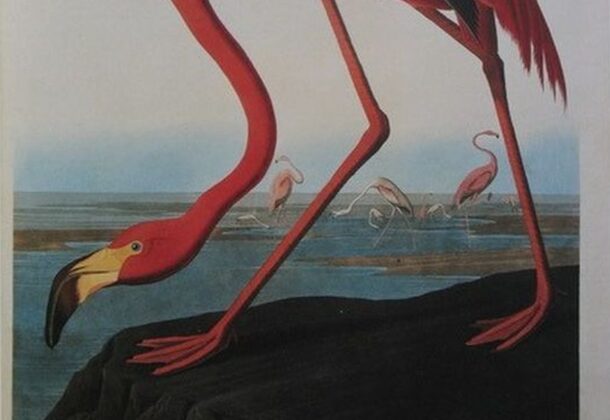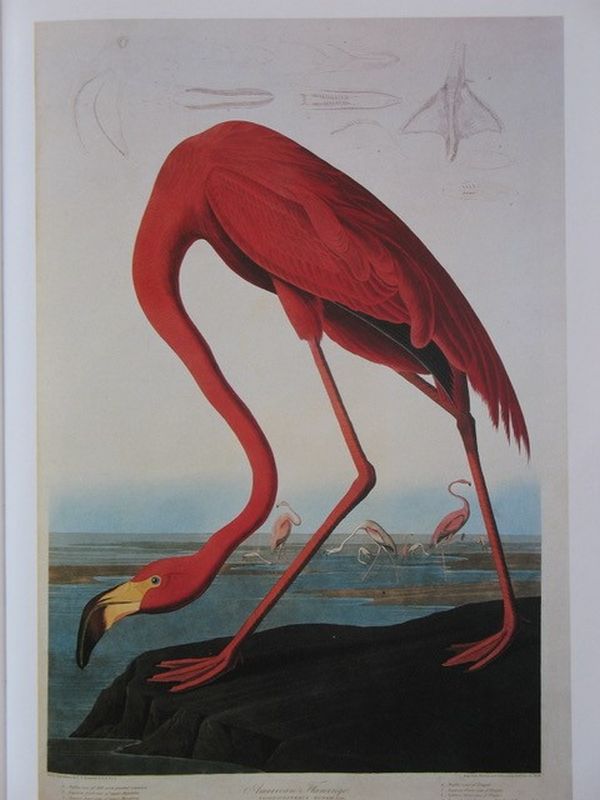Audubon Revolutionized Art of Bird Painting

The last flamingo painting in flamingo history brought to you by Dennis B. Williams Rare and Antique Bird Prints is by John James Audubon (1785-1851), the best bird illustrator of all time.
Audubon revolutionized the art of bird painting by making the birds look alive with intelligence and personality. He was the first to attempt to portray lifelike images by threading the birds with wires to create a sense of action and movement.
By comparison, his predecessors painted static, taxidermy-like field guides.
He was also the first artist to depict the birds life-sized.
His famous Birds of America, published 1827-38, is an immense “double elephant” book measuring three feet by two feet. It is the largest bird book ever produced. He painted this incredibly richly colored flamingo bent over to get the four-foot-tall bird to fit on the page. His description of searching for flamingos in the Florida Keys is so lyrical and magical that we can see that Audubon was part painter, part poet.
On the 7th of May 1832, while sailing from Indian Key, one of numerous islets that skirt the south-eastern coast of the peninsula of Florida, I for the first time saw a flock of flamingoes. It was on the afternoon of one of those sultry days which, in that portion of the country, exhibit towards evening the most glorious effulgence that can be conceived. The sun, now far advanced on the horizon, still shone with full splendor, the ocean around glittered in its quiet beauty, and the light fleecy clouds that here and there spotted the heavens, seem like flakes of snow margined with gold. Our bark was propelled as if by magic, for scarcely was a ripple raised by her bows as we moved in silence. Far away to seaward we spied a flock of flamingoes advancing in “Indian Line,” with well-spread wings, outstretched necks, and long legs directed backwards. Ah! reader, could you but know the emotions that agitated my breast! I thought I had now reached the height of all my exceptions, for my voyage to the Floridas was undertaken in a great measure for the purpose of studying these lovely birds in their own beautiful islands.
The flamingos in this history presented by Dennis B. Williams Rare and Antique Bird Prints include:
The first, painted by the Governor of Roanoke and the next by Mark Catesby (1679-1749), an English nobleman and explorer.
Alexander Wilson — the father of American ornithology — was the third to paint the flamingo, ahead of John James Audubon. More details about that in “Wilson beat Audubon to the Birds.”
Sarah Stone (1760-1844) was the fourth painter to capture a flamingo on paper and the fifth rendition is Edward Lear’s (1812-1888), who painted the flamingo in the pose of a ballerina.
In the history of flamingo painting, following these first notable four, the next notable rendition is Edward Lear’s (1812-1888). Lear painted the captivating bird dramatically assuming the pose of a ballerina.
It was Alexander Wilson who published the first book in America of our birds with beautiful hand-colored lithographs. Dennis B. Williams Rare and Antique Bird Prints is liquidating the last of its collection. Information on available prints is available on their Member Page. Or email [email protected].




















